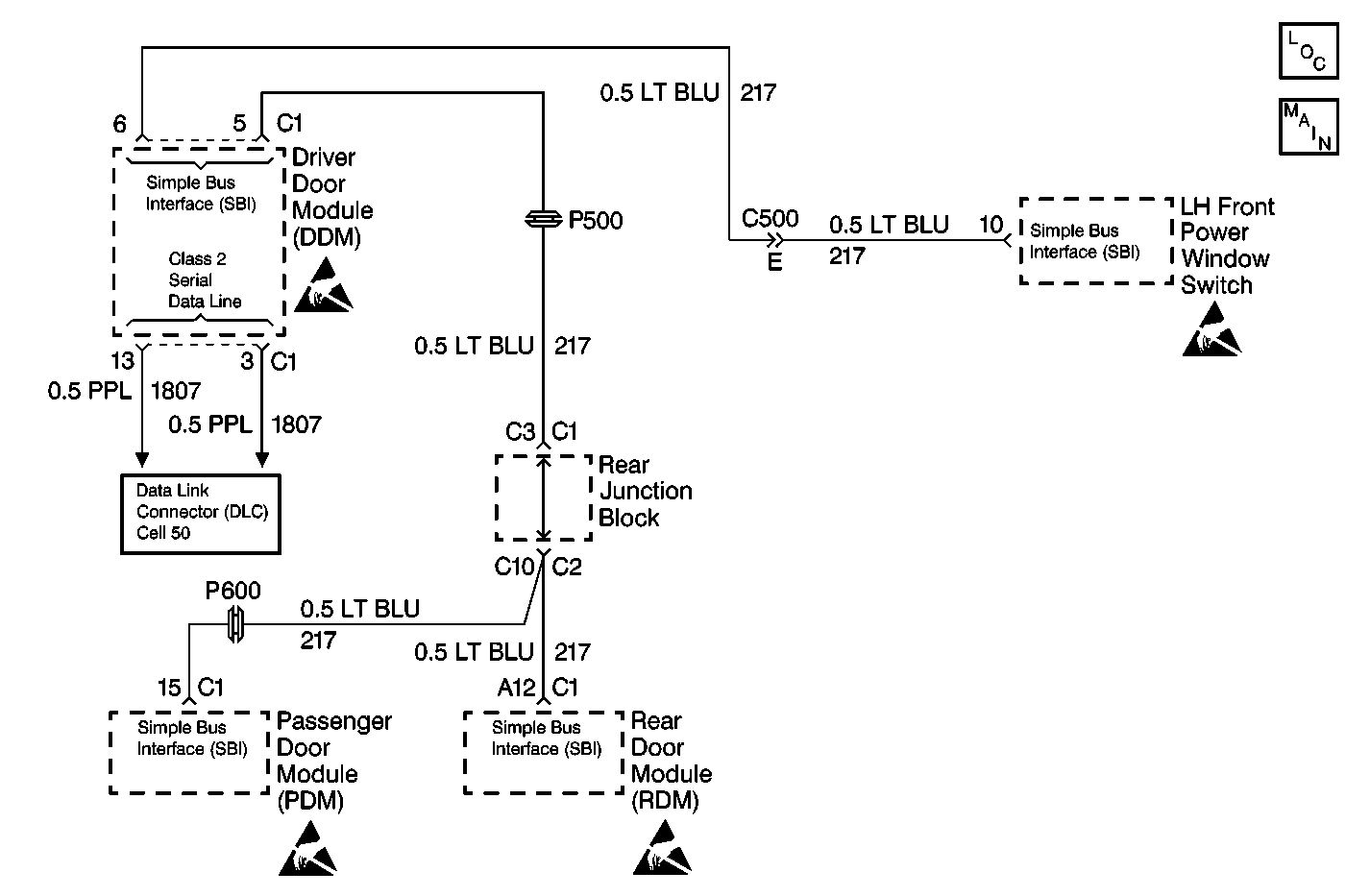
Circuit Description
The SBI data line communicates information between the door modules. Each module connected to the SBI is assigned a recognition code, or address. This code is used in order to identify which modules are communicating. Module communicate with each other by periodically sending state of health (SOH) messages. When the ignition switch is in RUN, each module communicating on the SBI sends an SOH message every 2 seconds. This ensures that the system is operating properly. When the LH power window switch stops communicating on the SBI, the SOH messages that is normally sent on the SBI disappears. the driver door module (DDM) which expects to receive that message detects the absence of the message and sets DTC U1170.
Conditions for Running the DTC
| • | The DDM does not receive an SOH message back from the LH power window switch. |
| • | The DTC only sets if U1300 or U1301 are not current. |
Action Taken When the DTC Sets
| • | DTC U1170 is stored in the DDM. |
| • | The DDM uses the default values for the initialization data. |
| • | This DTC does not cause a driver warning message to appear. |
Conditions for Clearing the DTC
| • | This DTC clears (status changes from current to history) under any of the following conditions: |
| - | The DDM detects an SOH message from the LH power window switch. |
| - | At each ignition cycle. |
| • | A history DTC clears after 50 consecutive ignition cycles if the conditions for setting the DTC are no longer present. |
| • | Current and history DTCs may be cleared using a scan tool. |
Diagnostic Aids
| • | DTC module U1170 does not normally represent a failure within the module. |
| • | If the DTC is a history DTC, the problem may be intermittent. |
The numbers below refer to the step numbers on the diagnostic table:
-
Perform the Door Control System Diagnostic System Check before you continue with the diagnosis of this DTC.
-
This is to test for other related DTCs.
Step | Action | Value(s) | Yes | No |
|---|---|---|---|---|
1 | Did you perform the Data Link Communications Diagnostic System Check? | -- | Go to Step 2 | |
2 | Are DTCs U1161 and U1162 also current? | -- | Go to Step 5 | Go to Step 3 |
3 | Inspect for an open in CKT 217 (LT BLU) between connector terminal 10 of the LF power window switch and connector C1 terminal 6 of the driver door module (DDM). Did you find a condition? | -- | Go to Step 4 | |
4 | Repair an open in CKT 217 (LT BLU). Did you complete the repair? | -- | Go to Step 23 | -- |
5 |
Does the voltage measure within the specified range? | 10-15 V | Go to Step 10 | Go to Step 6 |
6 | Measure the resistance from connector C1 terminal 6 of the DDM to ground. Does the resistance measure within the specified range? | 0-2ohms | Go to Step 13 | Go to Step 7 |
7 | Measure the voltage from connector C1 terminal 5 of the DDM to ground. Does the voltage measure within the specified range? | 10-15 V | Go to Step 15 | Go to Step 8 |
8 | Measure the resistance from connector C1 terminal 5 of the DDM to ground. Does the resistance measure within the specified range? | 0-2ohms | Go to Step 20 | Go to Step 9 |
9 | Replace the driver door module (DDM). Did you complete the repair? | -- | Go to Step 23 | -- |
10 |
Does the voltage measure within the specified range? | 10-15 V | Go to Step 11 | Go to Step 12 |
11 | Repair the short to battery positive voltage (B+) in CKT 217 (LT BLU). Did you complete the repair? | -- | Go to Step 23 | -- |
12 | Replace the LF power window switch. Did you complete the repair? | -- | Go to Step 23 | -- |
13 |
Does the resistance measure within the specified range? | 0-2ohms | Go to Step 14 | Go to Step 12 |
14 | Repair the short to ground in CKT 217 (LT BLU). Did you complete the repair? | -- | Go to Step 23 | -- |
15 |
Does the voltage measure within the specified range? | 10-15 V | Go to Step 17 | Go to Step 16 |
16 | Replace the rear door module (RDM). Did you complete the repair? | -- | Go to Step 23 | -- |
17 |
Does the voltage measure within the specified range? | 10-15 V | Go to Step 19 | Go to Step 18 |
18 | Replace the passenger door module (PDM). Did you complete the repair? | -- | Go to Step 23 | -- |
19 | Repair the short to battery positive voltage (B+) in CKT 217 (LT BLU). Did you complete the repair? | -- | Go to Step 23 | -- |
20 |
Does the resistance measure within the specified range? | 0-2ohms | Go to Step 21 | Go to Step 16 |
21 |
Does the resistance measure within the specified range? | 0-2ohms | Go to Step 22 | Go to Step 18 |
22 | Repair the short to ground in CKT 217 (LT BLU). Did you complete the repair? | -- | Go to Step 23 | -- |
23 |
Are all of the DTCs cleared? | -- | -- |
